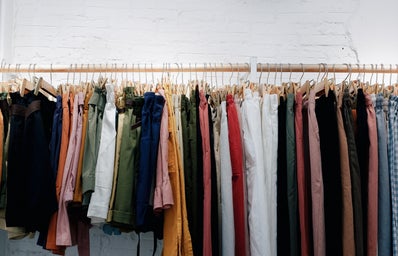Often when we think of slow fashion, we think of the brands that we buy from. The truth is, slow fashion is about more than just where we shop, but also how often we shop, and how we wear and repair our clothing. Slow fashion is more of a mindset than a label, and this simple guide will highlight the many ways that we can keep our closets more sustainable.
Try to Avoid the Guilt
It’s easy to feel guilty about not doing everything “right.” The world doesn’t make it easy to adhere to a slow fashion mindset. Buying clothing that is marketed as sustainably produced can be on the expensive side and is not always financially feasible. The good news is that slow fashion goes beyond what we buy, and it is still possible to be more eco-conscious about our clothing without spending more. In fact, having a slow fashion perspective can save us money by sourcing our clothing consciously and purchasing less frequently. It’s important to remember throughout our slow fashion journey that there is no way to be “perfect”, and that making an effort is already great enough.
Think about Where You Purchase From
Keeping in mind that accessibility is an important factor to consider when talking about shopping, thinking about what brands we buy from is an important step, but not the only one. A good place to start is to consider the brands that we purchase from, their practices, and their quality. Do this brand’s views align with my own? Will this piece of clothing be something that I will wear often or for a long time? These are questions that we can ask ourselves when buying new. There are also many ways to find preloved and new-to-you clothing at a fraction of the cost. Thrifting, attending second hand stores and clothing-swaps, and checking out Instagram and Facebook Marketplace for second hand clothing are all great ways to add to our wardrobes without buying brand new.
Think about How Often You Purchase
Am I a frequent shopper? Do I tend to buy new clothes knowing I have some neglected pieces waiting for me in my closet? These are important questions to ask ourselves when considering how often we purchase new clothing. With ever-changing tik-tok and media fashion microtrends, it’s easy to become concerned with what’s “in” right now and to adhere to what everyone else is wearing. These microtrends can cause us to shop more frequently than needed to adhere to trends. Considering our own personal style and thinking about clothing that we will wear regardless of if it’s “in” or “out” can help us to be more sustainable.
Make Repairs and Alterations
It’s always a great idea to break open the sewing kit when something needs a quick mend. Clothes tend to take a little bit of damage after a while, and that doesn’t mean that they need to be thrown out, they just need some TLC. There are plenty of youtube videos and tutorials online showing how to do simple alterations like patching holes, hemming items, resizing items, and making other simple repairs. Not only does mending save items from the landfill, it also saves us money by allowing us to get more wear out of clothes we already own.
Upcycle, Repurpose, Donate
Slow fashion must go beyond our consumption of clothing to also encapsulate the ways that we discard our clothing. Before throwing something away, we can ask ourselves if a piece still has potential. When we’re not loving certain pieces anymore, we can do some upcycling and breathe new life into our old clothes. This could include dyeing, fabric painting, cropping, and more. Even if something is beyond repair and wear, sometimes it can be repurposed into something new! Not only are these effective ways to avoid adding to the already appalling amount of clothing in landfills, but it also gives us a chance to be creative. When an item is still in good condition, but it’s time to part with it, consider giving it away to someone who may enjoy it, or donating. Donations of clothing can be made to many local shelters and charities, thrift stores, and more.


